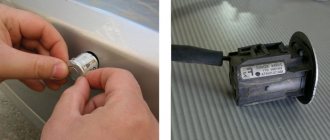For what reasons does the alarm go off spontaneously?
Modern vehicle owners are so afraid of theft or damage to their own vehicle that today it is almost impossible to find a car that is not equipped with anti-theft systems. In addition, in recent years, with the increase in the market for inexpensive alarm systems and their even cheaper Chinese analogues. In cars of the budget category, many of which in Russia have installed precisely similar systems, which becomes the cause of numerous complaints from car owners.
Complaints from car owners
Mostly, car owners complain about breakdowns such as:
- In most cases, the key fob does not work correctly: the doors may open with a huge delay, or the central locking may not turn on at all. The problem is most likely in the central unit, which is responsible for controlling the security system, or in the key fob. We try to bring the key fob near the vehicle, and if in this case everything can work properly or something
The signal may be jammed, or the key fob needs to be changed. In other options, repair of the central control units of the anti-theft system is required. - Another much more common reason is that the alarm goes off on its own. In most cases, this becomes the reason that you cannot get into the vehicle, or even worse, during the period of your absence from the signal, the battery of your vehicle has completely discharged. In most cases, this is not even a malfunction as such. In some cases, when the correct alarm setting can solve the problem. For example, most likely the system turns on on its own if its sensitivity is set to the maximum range; you just need to reduce it and everything will be in perfect order. Although, let's look at all the possible situations of this breakdown in detail.
What should you do if your car alarm goes off by itself?
Today, almost all car models leave the factory with built-in alarms.
They help protect movable property from criminals. Despite this, vigilant and scrupulous owners use additional safety features. This greatly reduces the risk of theft. Even the most popular security system can malfunction. One of these is the spontaneous activation of sensors or alarms.
False alarms reduce the car owner’s vigilance over time and worsen the performance of the alarm itself. All this happens if the problem is not corrected in a timely manner. Such malfunctions may result from improper installation or configuration. But that is not all. Today we will look in detail at each of the possible reasons. The recommendations presented are suitable for most security systems and vehicles.
What are the reasons for the alarm to turn on spontaneously?
As experienced drivers say, there are only three main reasons that the anti-theft system turns on independently:
- Damage to the alarm or some sensors. You can only fix the breakdown at a car service center; you can take advantage of warranty repairs, which will not cost you anything. The only problem is that you won’t be able to identify such breakdowns on your own; you can use the help of a qualified specialist.
- Items that are left in the vehicle interior. If the luggage is very large, it can send an alert to the internal volume sensor, in which case the anti-theft system will work independently.
- Incorrect operation of the door trunk or hood switch. Then, when the alarm turns on, an icon will appear on the screen indicating that the door or trunk is open. The main reasons are: oxidation or severe wear of the limit switches. You can lubricate the part with an anti-corrosion fluid, but it is recommended to completely change it - this way you are guaranteed to solve the problem.
The alarm can turn on by itself even during precipitation. The reason is water, which ends up in the system and disrupts its normal operation. There is only one way out: turn off the anti-theft system and give it time to dry completely.
Excessive sensitivity of the alarm system sensor. This breakdown can be corrected by correct system settings - we just reduce its sensitivity.
Sensitivity of car security equipment
If the equipment on the car has not been installed for so long, then the sensitive shock sensor becomes the reason why the alarm on the car goes off for no reason. The culprit is its incorrect adjustment. The element is set to a sensitivity level that is too high. And if the area where the car owner lives and constantly parks his car is quite quiet, then excessive sensitivity is not a terrible problem. But if there is a highway near the parking lot, a place where young people like to gather, a construction site, an airport or some other similar object, then the shock sensor will respond to any loud sounds by turning on the siren.
This problem can be corrected by simply reducing the susceptibility or sensitivity of the shock sensor.
How to set up an alarm?
Thus, if the anti-theft system turns on by itself, most likely the main reason is the sensor is not working properly. Basically we are talking about the shock sensor, the sensitivity of which we will need to reduce. Ideally, this sensor is triggered only during a strong impact on the vehicle body and does not howl from wind gusts, fireworks, or sounds from a vehicle passing nearby. If you installed a shock sensor consisting of two levels, then it is triggered in these options.
But it can only send a signal with the help of headlights - after blinking a couple of times, there should be no sound signals, and besides, there should be no howling.
Sometimes some models of budget alarms can reduce the sensitivity of the sensor quite easily. Thus, let’s consider the answer to the question of how to set up an alarm when it goes off spontaneously:
- First, let's find just the sensor. Basically, it is located in the interior of the vehicle, mainly among the front seats, right under the manual brake.
- Having found the sensor, we look at a special rotary type regulator located in the upper area. We rotate it in the opposite direction counterclockwise, which reduces the sensitivity of the alarm system.
- If the above methods do not help, then it is better to re-enable the sensor - just turn it off and on again. Most likely, the sensor freezes a little and this can solve the problem.
In a premium alarm system, things are not so easy. Settings there are carried out using special software, directly through the central control unit of the system. It is better not to do this on your own, but rather to entrust all the work into the hands of professional employees. Otherwise, if you interfere with the operation of the alarm system, you may risk damaging the system and you will lose the warranty that is provided when purchasing the system.
Differences
There are differences on older systems - in this case, the sensitivity threshold is adjusted not by electronics, but by a special screw. To reduce it, the element is rotated counterclockwise. On more modern models, buttons are used instead. The scale has several levels, which indicate the degree of response of the device. Standard adjustments are level 5 out of 10 possible on most systems. During the setup process, you should not increase the sensitivity too much, because the security device can only be triggered on average 10-12 times per cycle.
After this, the system is re-armed and then the configuration continues.
Faulty limit switches
Electrical circuit devices that close them are collectively called limit switches. Car alarms are equipped with limit switches that are installed in doorways, the engine compartment, and the trunk.
Faulty limit switches are often the reason why car alarms in vehicles go off. The malfunction is determined by the indication of the corresponding icon on the key fob screen. The main reasons for incorrect operation of the switch:
- Problems with electrical contacts;
- Oxidation or wear of connecting elements;
- Damage to electrical wires.
Only high-quality diagnostics of all protection elements will allow us to determine the true cause of the operation. In some cases, ordinary alarm prevention is enough: cleaning contacts; anti-corrosion treatment; replacing the wire. In other cases, the limit switches on the car are replaced.
Summary
These are the most common reasons - all car owners face them.
These problems have been discussed more than once in numerous automotive forums. To prevent this from happening, experts recommend not purchasing cheap products from China. It is better to purchase a reliable device from trusted manufacturers. Then you won’t have to rack your brains about why the car alarm goes off for no reason.
shock sensor triggered after arming B9
shock sensor triggered after arming B9
Andrey » Sun 22 Jun, 2008 18:13
Alex K » Sun Jun 22, 2008 6:22 pm
Andrey » Sun 22 Jun, 2008 20:45
Mikhail Chausov » Sun 22 Jun, 2008 21:01
Head of the federal support service StarLine 8-800-333-80-30 Russia 8-10-8000-333-80-30 Belarus 8-800-070-80-30 Kazakhstan 0-800-502-308 Ukraine free call
Alex K » Sun 22 Jun, 2008 21:05
instructions can be downloaded from here
in short - with the ignition off, press the Valet service button (not on the key fob!) 5 times, turn on the ignition (5 siren blasts will follow), press the Valet button 3 times (focusing on the LED lighting, 3 siren blasts will follow), then press the key fob buttons : #1 - for the 60 sec option. #2 - for a delay of 5 seconds. (default) #3 - for a delay of 30 seconds. book length #1 (before the melodic signal), then briefly on the book. #1 - 45 sec.
after that, an inscription like “3-3” will appear on the key fob, the key fob will beep several times. the ignition can be turned off.
For what reasons does the alarm go off spontaneously?
Modern vehicle owners are so afraid of theft or damage to their own vehicle that today it is almost impossible to find a car that is not equipped with anti-theft systems. In addition, in recent years, with the increase in the market for inexpensive alarm systems and their even cheaper Chinese analogues. In cars of the budget category, many of which in Russia have installed precisely similar systems, which becomes the cause of numerous complaints from car owners.
How to avoid malfunction of the alarm system?
In most cases, the cause of any type of breakdown in the operation of the alarm system is its incorrect installation. Therefore, when purchasing an anti-theft system, there is no need to leave its installation to garage professionals. When you contact an authorized service, you will most likely be able to get rid of many problems that are associated with the operation of your vehicle’s security systems.
The integrity of the car in the parking lot is one of the main concerns of the owner. The problem is solved by using a car alarm. The car alarm market is vast, there are a lot of offers - from simple to complex, with many options. Any security device mounted on a machine can be triggered randomly at the wrong time. In this article we will try to figure out why the alarm went off for no apparent reason and what caused it.
Methods for identifying the causes of false alarms
- Articles
- Maintenance and repair of security systems
- Methods for identifying the causes of false alarms
13 May 2011
- Share
False alarms are the most unpleasant drawback that a fire and security alarm system can have. Unfortunately, nowhere in the promotional materials will you find any parameters that allow you to assess the likelihood of false alarms. Even worse, any technology, no matter how wonderful, can become a victim of poor installation, the effects of time or interference. Therefore, installers and especially operators must know the possible causes of false alarms and be able to look for them.
The most common cause of false alarms is poor contact in the alarm loop. It’s not for nothing that electronics is jokingly called the science of contacts: their absence where they are needed, and their presence where they should not be. Twists, cheap steel terminal blocks, broken single-core wires - and after a year or two you begin to lose contact.
A very unpleasant malfunction, depending on the temperature or humidity of the air, it may not appear for months, but will come to the surface, for example, at minus 30 outside, to make it “more pleasant” to look for it. Or it will appear at night, and a repairman comes during the day - everything is in order, everything works. Such a malfunction is very difficult to identify and eliminate.
Often the cause is electromagnetic interference. Moreover, interference can affect both the receiving and control device and (more often) the sensors (detectors) themselves. This nuisance is typical for fire smoke detectors installed on a suspended ceiling. In this case, the cable cable often simply lies on the ceiling frame, mixed with lighting cables. And gas-discharge lamps themselves with high-frequency (chokeless) ballasts are often a source of terrifying interference, and they are located very close to fire detectors.
The third most common cause is installation errors. In this case, I do not mean poor wiring, but poor mechanical installation of devices. For example, the reed switch is placed crookedly, the magnet has become slightly demagnetized over time, the wooden door has become dry and warped, and now the reed switch honestly gives the “door open” signal. If you press harder, that’s normal; if you slightly pull the locked door, there’s an alarm. Most reed switches have a reliable operation distance of only 1–2 cm. Such a malfunction can be easily identified if you glue a magnet to the reed switch (do not forget that you have actually turned off the reed switch - it has stopped detecting the opening of the door). If the false alarms stopped during the test, then this is precisely the problem; mount the reed switch and the mating part (magnet) on the door more carefully, or even replace the reed switch with a more “long-range” one.
By the way, the opposite malfunction is also common: the reed switch stops signaling that the door is opening. This happens on steel doors if the frame itself is sufficiently magnetized. In addition to reed switches, poor installation can also affect, for example, infrared motion sensors. The sensor hangs on one screw and sways from the slamming of doors in the neighboring rooms. And in his field of vision is a heating radiator. If the sensor were rigidly fixed, the battery would not interfere with it. And so - here are false alarms for you.
In general, infrared sensors are easy to place incorrectly - opposite a window and a radiator. Theoretically, it will still work, but a window flapping in the wind or a fluttering curtain objectively provides a rapid change in the temperature distribution in the field of view of the sensor. This cannot even be called a false alarm - the sensor honestly detects the movement of something warm against the background of a cold one. Similarly, an acoustic glass break sensor can objectively respond to a very strong sharp sound (almost anyone can be alarmed if you clap your hands directly in front of it). There is no need to unconditionally believe what they say and write about complex spectral analysis. Yes, computer programs can differentiate sounds very accurately. But in order for serial sensors to be able to distinguish the sound of glass so well from other similar sounds, they also need to have a Pentium installed at several gigahertz. True, they would then consume like a computer and cost the same. Therefore, I don’t even consider the glass break sensor in the dining room, where knives are constantly being dropped on the tiles, to be false alarms. If this is a problem for you, turn up the sensitivity. Or place the sensor behind the curtains near the window - then it will clearly hear the sound of breaking glass and will not hear the sounds of the New Year's corporate party from the room.
Now let's look at how to find and fix the problem. The main principle: the source of false alarms must first be localized. This is not easy; false alarms, as already mentioned, can occur quite rarely (but often enough that it irritates the customer). You arrive at the site, tighten all the screws in the connections, check the integrity of the wires, even test the loop with a tester (ohmmeter) and make sure that everything seems to be normal, and a week later you are again told that there were two false alarms. Well, it's time to tackle the problem systematically.
First question: do false alarms always occur in the same loop or in different ones? If the control panel has a good event log and you can view it, great. If not, you will have to negotiate with the guards on duty so that they record when and which light was on during an alarm. How to negotiate is not a question for me. If you don’t know how, read about the art of getting along with people or other similar opuses. As a result, you will know where alarms occur and when. Sometimes it is possible to compare the time of alarms with the switching on of, for example, industrial equipment - this means that the problem is electromagnetic interference and it is necessary to shield, ground, or, conversely, power it from separate power sources according to the manufacturer’s recommendations. Discuss countermeasures with the system developer, they will not be happy, but they will recommend something. Or you can simply replace faulty detectors with other types (for example, smoke with heat) - this can also help.
If false alarms occur more or less evenly in all loops, there is probably a problem with the control panel. Replace it, preferably with a different model. If it doesn’t help, we assume that the system as a whole is simply neglected (or there are equally low-quality detectors everywhere), and we begin to fight each loop in turn (if there are many loops in the system, then it’s better to have several at a time). During such a fight, parts of the system are disabled for some time and the security of the site is reduced, so do not forget to coordinate this with the person responsible for security. It may even be necessary to temporarily deploy a backup system, for example, a radio channel; it is easier to quickly install and then dismantle.
So, troubleshooting in a separate loop. The only scientific method is the halving method. Break the cable in the middle, move the end-of-line resistor there (or better yet, install a new end-of-line resistor) and wait for a while. If previously false alarms happened about once a week, you need to wait about a month. There are no false alarms - the problem is in the cut piece of the cable. We connect it back and cut this piece in the middle, so that now ¾ of the cable remains connected.
If at the first stage there were false alarms, then the problem is on the connected part (there may also be problems in the cut piece, but first we will try to catch at least one by the tail). We divide the nearest piece in half again (¼ of the cable remains connected) and wait again.
And so on until we find a specific sensor that gives false alarms. Attention: if, for example, all sensors give electromagnetic interference and false alarms evenly, then as pieces of the cable are cut off, alarms will occur less and less often. If so, increase the exposure time. The whole epic, if false alarms are not very frequent and the loops have many sensors on each, can last for months.
The second way is to replace the equipment. It is especially appropriate if there are a lot of false alarms on different loops. You choose one of the cables and change all the sensors on it to the most reliable and expensive ones you can afford. For one loop, this is usually not that expensive. Although it is very labor-intensive and often ugly in terms of the cheapest ones - reed switch security sensors. If it helps, then in the case of a security loop with different types of sensors, you can gradually put back different types of sensors and thus find out which sensors are the problem. It’s more difficult with firefighters - there usually the entire train consists of identical sensors, and if replacing with good ones helped, then it means that before there were just all the bad ones. It’s not that they were all hopelessly bad. Perhaps in other situations they can work, but specifically in yours, at this facility, they are unsuitable. In the case of fire sensors, there is also another reason: cheap products can have a very wide range of parameters. Half of them, for example, are quite resistant to interference, and some are triggered, as they say, by a sideways glance. If it is economically justified, you can gradually, several pieces at a time, put back the old sensors. You may be able to select those that do not give false alarms.
A special case is address systems. Of course, addressable detectors are usually more expensive and of higher quality than conventional ones. But there are no perfect products. In many cases they can also give false alarms. But finding problems is much easier. Firstly, you don’t have to worry about dividing the loop in half; you initially know which detectors give a false alarm. This will already save you several months. Secondly, all addressable systems I know of have good event logging capabilities, so you can get information down to the minutes or even seconds when false alarms occurred. Finally, addressable detectors often provide detailed diagnostic capabilities or customization of their parameters. You can change some parameters, or at least simply coarse the sensitivity. I won’t give specific recommendations, it all depends on the types of devices.
In general, troubleshooting in an addressable system is much more pleasant than in a non-addressable one. Instead of running around the site with a stepladder and tools, most operations can be performed from the system control panel. However, in the address system, the same labor-intensive and time-consuming method of halving may be necessary. This is usually necessary if the problem is an intermittent loss of communication with individual detectors. If the issue is poor contact (break of the loop), then the location of the damage to the loop can be calculated by analyzing which detectors the connection is lost with, and with which it is always stable. If the reason is a short circuit in the communication line, then you will have to divide it in half. However, even in this case the situation is easier than in the non-addressed one. When dividing in half, it is not necessary to completely disconnect the rest of the loop; it is enough to insert one or more short circuit insulators. When the short circuit makes itself known, it will disconnect the damaged section, and you will know where to look for the problem.
In conclusion, we will describe recommendations for combating electromagnetic interference. This activity is not so much a science as an art. Some consider it shamanism. Indeed, in complex systems consisting of hundreds of products, connected by kilometers of cable and located among many other electrical installations, it is simply impossible to accurately calculate the effect of one device on another. The same actions may help in one case, but in another they will only worsen the situation. But there are general principles that should be understood so as not to try all possible combinations through trial and error.
The first recommendation from manufacturers of all systems is to use shielded cable. Yes, this often helps. Although in an existing system it is usually almost impossible to replace an already installed cable with a shielded one. Nevertheless, let's look at some details. The shield on the cable itself can help a lot. Even if you don't connect it anywhere. Often the best solution is to leave the cable shield unconnected. In any case, the screen equalizes the influence of interference on all wires in the cable, and therefore the differential interference signals applied to the devices are reduced.
Under no circumstances should the screen be grounded (or connected anywhere at all) at both ends. Because in this case the screen becomes not a screen, but an additional conductor through which a weakly predictable current flows. This is called an earthen loop, more on that below. Often the optimal solution is to ground or neutralize the screen from the control panel side. It is the PPK that receives the signal from the loop, and if the screen is connected to a reference point inside the PPK, then the interference on all cable cores relative to this point will be minimal. Depending on the circuit design, the optimal solution may not be grounding, but a connection, for example, to the control panel body, to the negative power supply wire of the control panel, or even to the negative wire of the loop. By the way, the PPK case, if it is metal, in theory, must be grounded. But in practice, if the ground (the third wire in the power supply) is not of very high quality (it itself contains a lot of noise), it may turn out that it is better not to connect anywhere than to such a ground.
In addition to cable shielding, shielding of the noise-prone detector is sometimes used. A sheet of copper foil or galvanized sheet is placed under the detector on the side of the expected source of interference (for example, if there is an elevator motor or milling machine behind the wall). Aluminum foil from a chocolate bar is ineffective because it has rather low conductivity. It is often useful to connect such a screen to the minus power supply of the detector with a separate, fairly thick wire. Often the route of interference is through unplanned contact. The worst thing is when one or different wires in the system are grounded in different places. The same earthen loop mentioned above. Different points on the ground have very different potentials (the ground is not a very good conductor), as a result, a so-called equalizing current will flow through a wire grounded in several places. This could include the reverse current from a passing tram (in theory, it should flow along the rails, but if there is poor contact, it will flow through your cable just fine) or the balun current of a three-phase rolling mill motor. There are known cases when such a current evaporated poorly grounded cables and completely damaged equipment. The result, as a rule, is not so tragic, but the influence of interference increases many times over.
Please note: multiple grounding may occur against your wishes. For example, a train laid with noodles was secured with nails. The nail touched one of the wires and the grounded plaster mesh - and that’s it, here it is, an unexpected secondary grounding point. In theory (according to GOST), all PPK are designed to operate with a leakage resistance in the loop up to 50 or even 20 kOhm. But the possible impact of interference from such a leak to ground is unpredictable. Often, when checking loops, only the resistance and insulation between the wires are checked. Don't forget to check for ground leakage - this is even more important from an interference standpoint. If the resistance to ground is less than 1 megohm, problems are very likely.
Another way for interference to penetrate is to lay the power supply line for the detectors and the signal line in different cables. This occurs if remote detectors are connected to a separate power source located near them. In this case, the noise induced on the power line and on the signal line is different, and this potential difference is applied to the detector. Again, in theory (more precisely, according to GOST), detectors should easily tolerate interference from the loop. But the possible interference is much more diverse than the test interference used during testing. Maybe everything will be fine, maybe not.
By the way, a potential source of problems is the ring loop, popular in fire alarms. Such a loop could turn out to be a huge loop antenna, very susceptible to both magnetic and electric fields over a wide range. If the control panel does not provide a sufficient degree of insulation between the two ends of the ring loop (and many control panels do not isolate them at all), then if you suspect electromagnetic interference, you can try to break the ring. May I help.
Another source of interference is the power supply. Try turning it off. Absolutely, both wires. Let the system run on battery power for a while. If it helps, false alarms have stopped - install an isolating transformer, stabilizer, online UPS - all these are possible ways to isolate yourself from interference coming from the power supply.
And finally, as a last resort, I can advise trying to break one large system into several small ones. Instead of one 48-loop device, install three 16-loop devices connected to different power supplies. Or one integrated system can be divided into several autonomous ones. The problem may be that the system of directly connected devices is larger than what is allowed for the location. Again, if it helps, then you can later, taking precautions, for example with galvanic isolation of communication lines, connect the system back into a single one. The main thing is to determine the source of the problem, then it will be possible to find a suitable solution.
Source: TK Magazine No. 1 2011
Poor installation, configuration or repair
The installation, followed by setting up the alarm on the machine, should be given close attention. The result of poorly performed work will be the activation of a car alarm anywhere, at any time.
This applies equally to repair work. When choosing a contractor, the car owner must take care of the impeccable reputation of the specialist and service center. Finding information today is not difficult. Our specialists know about faulty alarms and how they can be eliminated.











